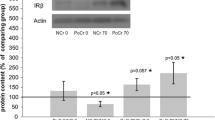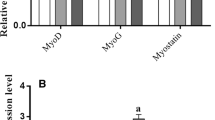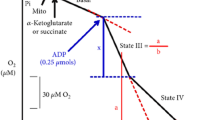Abstract
The study was conducted to evaluate the effects of chromium-loaded chitosan nanoparticles (Cr-CNP) on glucose transporter 4 (GLUT4), relevant messenger RNA (mRNA), and proteins involved in phosphatidylinositol 3-kinase (PI3K), Akt2-kinase, and AMP-activated protein kinase (AMPK) of skeletal muscles in finishing pigs. A total of 120 crossbred barrows (BW 65.00 ± 1.26 kg) were randomly allotted to four dietary treatments, with three pens per treatment and 10 pigs per pen. Pigs were fed the basal diet supplemented with 0, 100, 200, or 400 μg/kg of Cr from Cr-CNP for 35 days. After the feeding trials, 24 pigs were slaughtered to collect longissimus muscle samples for analysis. Cr-CNP supplementation increased GLUT4 messenger RNA (mRNA) (quadratically, P < 0.01) and total and plasma membrane GLUT4 protein contents (linearly and quadratically, P < 0.001) in skeletal muscles. Glycogen synthase kinase 3β (GSK-3β) mRNA was decreased linearly (P < 0.001) and quadratically (P < 0.001). Supplemental Cr-CNP increased insulin receptor (InsR) mRNA quadratically (P < 0.01), Akt2 total protein level linearly (P < 0.01) and quadratically (P < 0.001), and PI3K total protein was increased significantly (P < 0.05) in 200 μg/kg treatment group. The mRNA of AMPK subunit gamma-3 (PRKAG3) and protein of AMPKα1 was significantly increased (P < 0.001) with the addition of Cr-CNP. The results indicate that dietary supplementation of Cr-CNP may promote glucose uptake by leading to recruitment of GLUT4 to the plasma membrane in skeletal muscles, and these actions may be associated with the insulin signal transduction and AMPK.




Similar content being viewed by others
References
Meng SX, Cao JM, Feng Q et al (2013) Roles of chlorogenic acid on regulating glucose and lipids metabolism: a review. Evid-Based Compl Alt 2013:ID 801457
Konner AC, Bruning JC (2012) Selective insulin and leptin resistance in metabolic disorders. Cell Metab 16:144–152
Yang JJ, Xu YY, Qian K et al (2016) Effects of chromium-enriched Bacillus subtilis KT 260179 supplementation on growth performance, caecal microbiology, tissue chromium level, insulin receptor expression and plasma biochemical profile of mice under heat stress. Br J Nutr 115:774–781
Cline GW, Petersen KF, Krssak M et al (1999) Impaired glucose transport as a cause of decreased insulin-stimulated muscle glycogen synthesis in type 2 diabetes. N Engl J Med 341:240–246
Huang S, Czech MP (2007) The GLUT4 glucose transporter. Cell Metab 5:237–252
Birnbaum MJ (1989) Identification of a novel gene encoding an insulin-responsive glucose transporter protein. Cell 57:305–315
Saltiel AR, Kahn CR (2001) Insulin signaling and the regulation of glucose and lipid metabolism. Nature 414:799–806
Winder WW, Hardie DG (1999) AMP-activated protein kinase, a metabolic master switch: possible roles in type 2 diabetes. Am J Phys 277:E1–E10
Mertz W (1993) Chromium in human nutrition: a review. J Nutr 123:626–633
Offenbacher EG, Pi-Sunyer FX (1988) Chromium in human nutrition. Annu Rev Nutr 8:543–563
Anderson RA (1997) Chromium as an essential nutrient for humans. Regul Toxicol Pharmacol 26:S35–S41
Vincent JB (2004) Recent advances in the nutritional biochemistry of trivalent chromium. Proc Nutr Soc 63:41–47
Cefalu WT, Wang ZQ, Zhang XH et al (2002) Oral chromium picolinate improves carbohydrate and lipid metabolism and enhances skeletal muscle Glut-4 translocation in obese, hyperinsulinemic (JCR-LA corpulent) rats. J Nutr 132:1107–1114
Di Bona KR, Love S, Rhodes NR et al (2011) Chromium is not an essential trace element for mammals: effects of a “low-chromium” diet. J Biol Inorg Chem 16:381–390
Mooney KM, Cromwell GL (1997) Efficacy of chromium picolinate and chromium chloride as potential modifiers in swine. J Anim Sci 73:3351–3357
Page TG, Southern LL, Ward TL et al (1993) Effect of chromium picolinate on growth and serum and carcass traits of growing-finishing pigs. J Anim Sci 71:656–662
Kim BG, Lindemann MD, Cromwell GL et al (2010) The effects of dietary chromium (III) picolinate on growth performance, vital signs, and blood measurements of pigs during immune stress. Biol Trace Elem Res 135:200–210
Hoffman NJ, Penque BA, Habegger KM et al (2014) Chromium enhances insulin responsiveness via AMPK. J Nutr Biochem 25:565–572
Kegley EB, Spears JW, Brown TT et al (1996) Immune response and disease resistance of calves fed chromium nicotinic acid complex or chromium chloride. J Dairy Sci 79:1278–1283
Shelton JL, Payne RL, Johnston S et al (2003) Effect of chromium propionate on growth, carcass traits, pork quality, and plasma metabolites in growing-finishing pigs. J Anim Sci 81:2515–2524
Zhao P, Wang JY, Ma H et al (2009) A newly synthetic chromium complex-chromium (D-phenylalanine)3 activates AMP-activated protein kinase and stimulates glucose transport. Biochem Pharmacol 77:1002–1010
Wang MQ, Xu ZR (2004) Effect of chromium nanoparticle on growth performance, carcass characteristics, pork quality and tissue chromium in finishing pigs. Asian-Australas J Anim Sci 17:1118–1122
Wang MQ, Xu ZR, Li WF et al (2009) Effect of chromium nanocomposites supplementation on growth hormone pulsatile secretion and mRNA expression in finishing pigs. J Anim Physio Anim Nutr 93:520–525
Wang MQ, Xu ZR, Zha LY et al (2007) Effects of chromium nanocomposites supplementation on blood metabolites, endocrine parameters and immune traits in finishing pigs. Anim Feed Sci Technol 139:69–80
Hao C, Hao J, Wang W et al (2011) Insulin sensitizing effects of oligomannuronate-chromium (III) complexes in C2C12 skeletal muscle cells. PLoS One 6:e24598
Tian YY, Zhang LY, Dong B et al (2014) Effects of chromium methionine supplementation on growth performance, serum metabolisms, endocrine parameters, antioxidant status, and immune traits in growing pigs. Biol Trace Elem Res 162:134–141
Lien TF, Horng YM, Yang KH (1999) Performance, serum characteristics, carcass traits and lipid metabolism of broilers as affected by supplement of chromium picolinate. Br Poult Sci 40:357–363
Qiao W, Peng Z, Wang Z et al (2009) Chromium improves glucose uptake and metabolism through upregulating the mRNA levels of IR, GLUT4, GS, and UCP3 in skeletal muscle cells. Biol Trace Elem Res 131:133–142
Wang MQ, Ye SS, Du YJ et al (2012) The preparation and use of chitosan nanoparticles loaded with chromium ions as a carcass modifier. Patent no. ZL 201110167430.9. Zhejiang University, Hangzhou
Wang MQ, Wang C, Li H et al (2012) Effects of chromium-loaded chitosan nanoparticles on growth, blood metabolites, immune traits and tissue chromium in finishing pigs. Biol Trace Elem Res 149:197–203
Wang M, Gao XJ, Zhao WW, Zhao WJ, Jiang CH et al (2013) Opposite effects of genistein on the regulation of insulin-mediated glucose homeostasis in adipose tissue. Br J Pharmacol 170(2):328–340
Sancheti H, Akopian G, Yin F, Brinton RD, Walsh JP et al (2013) Age-dependent modulation of synaptic plasticity and insulin mimetic effect of lipoic acid on a mouse model of Alzheimer’s disease. PLoS One 8(7):e69830. doi:10.1371/journal.pone.0069830
Chen GL, Liu P, Pattar GR et al (2006) Chromium activates glucose transporter 4 trafficking and enhances insulin-stimulated glucose transport in 3T3-L1 adipocytes via a cholesterol- dependent mechanism. Mol Endocrinol 20:857–870
Pattar GR, Tackett L, Liu P et al (2006) Chromium picolinate positively influences the glucose transporter system via affecting cholesterol homeostasis in adipocytes cultured under hyperglycemic diabetic conditions. Mutat Res 610:93–100
Wang YQ, Yao MH (2009) Effects of chromium picolinate on glucose uptake in insulin-resistant 3T3-L1 adipocytes involve activation of p38 MAPK. J Nutr Biochem 20:982–991
Wang Y, Van Oort MM, Yao M et al (2011) Insulin and chromium picolinate induce translocation of CD36 to the plasma membrane through different signaling pathways in 3T3-L1 adipocytes, and with a differential functionality of the CD36. Biol Trace Elem Res 142:735–747
Pessin JE, Thurmond DC, Elmendorf JS et al (1999) Molecular basis of insulin-stimulated GLUT4 vesicle trafficking. J Biol Chem 274:2593–2596
Taha C, Klip A (1999) The insulin signaling pathway. J Membrane Biol 169:1–12
Hayashi T, Hirshman MF, Kurth EJ et al (1998) Evidence for 5′ AMP-activated protein kinase mediation of the effect of muscle contraction on glucose transport. Diabetes 47:1369–1373
Bryant NJ, Govers R, James DE (2002) Regulated transport of the glucose transporter GLUT4. Nat Rev Mol Cell Biol 3:267–277
Thong FS, Dugani CB, Klip A (2005) Turning signals on and off: GLUT4 traffic in the insulin-signaling highway. Physiology 20:271–284
Bae SS, Cho H, Mu J et al (2003) Isoform-specific regulation of insulin-dependent glucose uptake by Akt/protein kinase B. J Biol Chem 278:49530–49536
Jiang ZY, Zhou QL, Coleman KA et al (2003) Insulin signaling through Akt/protein kinase B analyzed by small interfering RNA-mediated gene silencing. Proc Natl Acad Sci 100:7569–7574
Sanz P (2008) AMP-activated protein kinase: structure and regulation. Curr Protein Pept Sci 9:478–492
Towler MC, Hardie DG (2007) AMP-activated protein kinase in metabolic control and insulin signaling. Circ Res 100:328–341
Milan D, Jeon JT, Looft C et al (2000) A mutation in PRKAG3 associated with excess glycogen content in pig skeletal muscle. Science 288:1248–1251
Cheung PC, Salt IP, Davies SP et al (2000) Characterization of AMP activated protein kinase gamma-subunit isoforms and their role in AMP binding. Biochem J 346:659–669
Barnes BR, Marklund S, Steiler TL et al (2004) The 5′-AMP-activated protein kinase γ3 isoform has a key role in carbohydrate and lipid metabolism in glycolytic skeletal muscle. Biochem J 279:38441–38447
Patel S, Macaulay K, Woodgett JR (2011) Tissue-specific analysis of glycogen synthase kinase-3alpha (GSK-3alpha) in glucose metabolism: effect of strain variation. PLoS One 6:e15845
Patel S, Doble BW, MacAulay K et al (2008) Tissue-specific role of glycogen synthase kinase 3β in glucose homeostasis and insulin action. Mol Cell Biol 28:6314–6328
Cline GW, Johnson K, Regittnig W et al (2002) Effects of a novel glycogen synthase kinase-3 inhibitor on insulin-stimulated glucose metabolism in Zucker diabetic fatty (fa/fa) rats. Diabetes 51:2903–2910
Dokken BB, Henriksen EJ (2006) Chronic selective glycogen synthase kinase-3 inhibition enhances glucose disposal and muscle insulin action in prediabetic obese Zucker rats. Am J Physiol Endocrinol Metab 291:E207–E213
Ring DB, Johnson KW, Henriksen EJ et al (2003) Selective glycogen synthase kinase 3 inhibitors potentiate insulin activation of glucose transport and utilization in vitro and in vivo. Diabetes 52:588–595
Zhang D, Fujii I, Lin C et al (2008) The stimulatory activities of polysaccharide compounds derived from algae extracts on insulin secretion in vitro. Biol Pharm Bull 31:921–924
Liu SH, Chang YH, Chiang MT (2010) Chitosan reduces gluconeogenesis and increases glucose uptake in skeletal muscle in streptozotocin-induced diabetic rats. J Agric Food Chem 58:5795–5800
Acknowledgements
This work was financially supported by the Program for Zhejiang Leading Team of S&T Innovation (2011R50025-04) and the National “Twelfth Five Year” Program for Science and Technology Support (2012BAD39B01).
Authors’ Contribution
The authors’ contributions are as follows: MW conceived and designed the experiments. WT, YH, and MW performed the experiments. YH, WT, LL, and MW analyzed and checked the data. MW, YH, LL, and BW contributed reagents/materials/analysis tools. LL, BW, MW, and ZL wrote the paper. The final manuscript was read and approved by all the authors.
Author information
Authors and Affiliations
Corresponding author
Ethics declarations
Conflict of Interest
The authors declare that they have no conflict of interest.
Rights and permissions
About this article
Cite this article
Liu, L., Wang, B., He, Y. et al. Effects of Chromium-Loaded Chitosan Nanoparticles on Glucose Transporter 4, Relevant mRNA, and Proteins of Phosphatidylinositol 3-Kinase, Akt2-Kinase, and AMP-Activated Protein Kinase of Skeletal Muscles in Finishing Pigs. Biol Trace Elem Res 178, 36–43 (2017). https://doi.org/10.1007/s12011-016-0890-1
Received:
Accepted:
Published:
Issue Date:
DOI: https://doi.org/10.1007/s12011-016-0890-1




